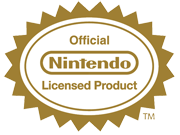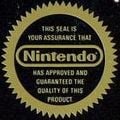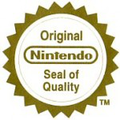Official Nintendo Seal: Difference between revisions
No edit summary |
mNo edit summary Tag: Mobile edit |
||
| Line 1: | Line 1: | ||
[[File:Official Nintendo Seal 2013.PNG|frame|The Official Nintendo Seal used in NTSC regions as of 2013]] | [[File:Official Nintendo Seal 2013.PNG|frame|The Official Nintendo Seal used in NTSC regions as of 2013]] | ||
The '''Official Nintendo Seal''', known in PAL regions as the '''Original Nintendo Seal of Quality''' and formerly known in NTSC regions as the '''Official Nintendo Seal of Quality''', is on the back of every current [[Nintendo]] official merchandise of any kind. After the {{wp|video game crash of 1983}}, customers were wary of buying video games since most recent games were of poor quality. To counter this, Nintendo placed the Nintendo Seal of Quality on all of its merchandise. The term "Seal of Quality" was somewhat misleading, in that it determined the quality of the hardware rather than the software; its presence indicated that a game would run as intended on the Nintendo system it was designed for without bricking the latter. The Seal was also used to distinguish legitimate commercial games from pirated knockoffs. In late-2003, Nintendo of America abandoned the "of Quality" part of the Seal's label, as by then consumers had come to understand that the presence of the Seal did not indicate how good or bad an approved game was. | |||
The '''Official Nintendo Seal''', known in PAL regions as the '''Original Nintendo Seal of Quality''' and formerly known in NTSC regions as the '''Official Nintendo Seal of Quality''', is on the back of every current [[Nintendo]] official merchandise of any kind. After the | |||
The original variant is used for games and various game-related hardware, such as alternate controllers. The "Licensed Product" seal is used for all other licensed products, including apparel, home entertainment releases, third party guides, and even SD cards. | The original variant is used for games and various game-related hardware, such as alternate controllers. The "Licensed Product" seal is used for all other licensed products, including apparel, home entertainment releases, third party guides, and even SD cards. | ||
==References in ''Mario'' games== | ==References in ''Mario'' games== | ||
*[[Cranky Kong]] often acts as a guide in [[Donkey Kong (franchise)|''Donkey Kong'' franchise]] | *[[Cranky Kong]] often acts as a guide in game manuals of the [[Donkey Kong (franchise)|''Donkey Kong'' franchise]], complaining about the lack of quality in the games and stating they are not worthy of the Official Nintendo Seal of Quality. | ||
==Gallery== | ==Gallery== | ||
Revision as of 12:04, March 22, 2023
The Official Nintendo Seal, known in PAL regions as the Original Nintendo Seal of Quality and formerly known in NTSC regions as the Official Nintendo Seal of Quality, is on the back of every current Nintendo official merchandise of any kind. After the video game crash of 1983, customers were wary of buying video games since most recent games were of poor quality. To counter this, Nintendo placed the Nintendo Seal of Quality on all of its merchandise. The term "Seal of Quality" was somewhat misleading, in that it determined the quality of the hardware rather than the software; its presence indicated that a game would run as intended on the Nintendo system it was designed for without bricking the latter. The Seal was also used to distinguish legitimate commercial games from pirated knockoffs. In late-2003, Nintendo of America abandoned the "of Quality" part of the Seal's label, as by then consumers had come to understand that the presence of the Seal did not indicate how good or bad an approved game was.
The original variant is used for games and various game-related hardware, such as alternate controllers. The "Licensed Product" seal is used for all other licensed products, including apparel, home entertainment releases, third party guides, and even SD cards.
References in Mario games
- Cranky Kong often acts as a guide in game manuals of the Donkey Kong franchise, complaining about the lack of quality in the games and stating they are not worthy of the Official Nintendo Seal of Quality.




